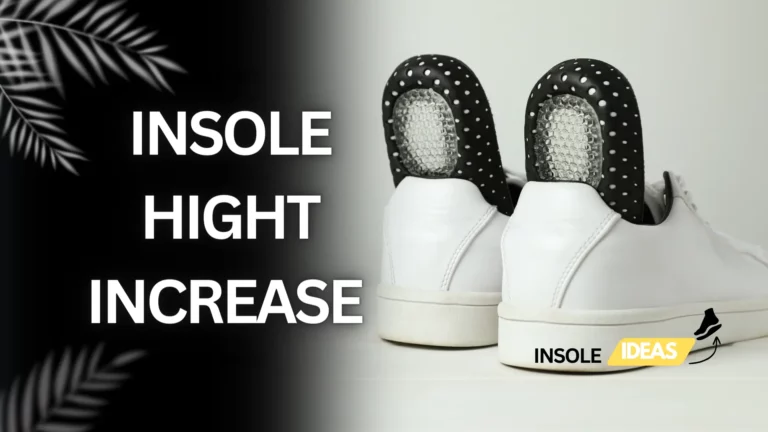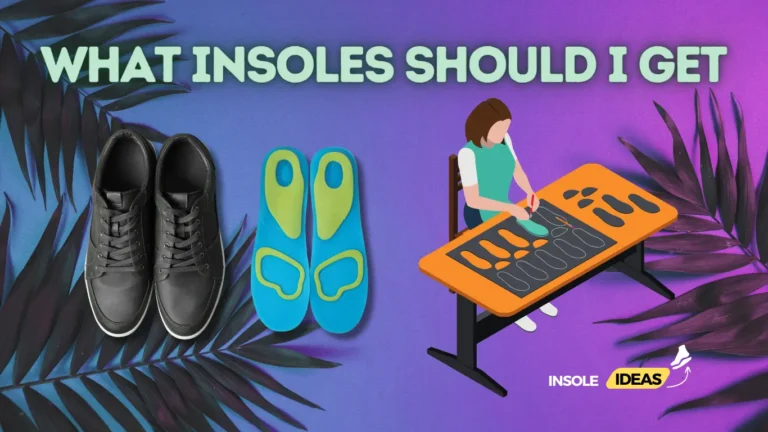How to Remove Glued Insoles: A Step-by-Step Guide
The importance of removing glued insoles cannot be overstated, as it directly impacts both the comfort and hygiene of your shoes. Glued insoles, while initially providing stability and support, can degrade over time, leading to discomfort and potential health issues. Additionally, removing glued insoles is essential for proper shoe maintenance and longevity. This article attempts to give a thorough rundown of the procedure while addressing frequent problems that people run into while trying to take out bonded insoles.
Importance of Removing Glued Insoles
Removing glued insoles is crucial for several reasons. Firstly, over time, glued insoles can lose their effectiveness, resulting in diminished comfort and support for the wearer. When using your feet for extended periods of time, this can cause weariness, discomfort, and even pain. Second, attached insoles may retain germs and moisture, which might lead to fungal diseases and offensive odors. By removing glued insoles regularly, you can maintain a healthier shoe environment and prolong the lifespan of your footwear.
Common Challenges Faced
Despite the importance of removing glued insoles, individuals often encounter various challenges during the process. One common issue is the strong adhesive used to secure the insoles to the shoe bed. This adhesive can be challenging to break down and remove, requiring patience and careful handling to avoid damaging the shoe or insole material. Additionally, the design of certain shoe models may make it difficult to access and remove the insoles without causing damage to other components. Understanding these challenges and employing the appropriate techniques can streamline the removal process and minimize potential damage.
Understanding Glued Insoles
To effectively remove glued insoles, it is essential to understand the types of adhesives used and their impact on shoe comfort and hygiene. Different adhesives exhibit varying levels of strength and solubility, influencing the difficulty of removal and the potential for residue buildup.
Types of Adhesives Used
Manufacturers commonly use a variety of adhesives to secure insoles to the shoe bed, including solvent-based adhesives, pressure-sensitive adhesives, and heat-activated adhesives. Solvent-based adhesives are often strong and durable but can be challenging to dissolve without damaging the shoe or insole material. Pressure-sensitive adhesives provide initial tackiness upon application but may weaken over time, making removal easier. Heat-activated adhesives require heat to activate their bonding properties and may necessitate specialized tools for removal. Understanding the type of adhesive used in your shoes can inform the appropriate removal method.
Impact on Shoe Comfort and Hygiene
The presence of glued insoles can significantly impact shoe comfort and hygiene. Over time, as the adhesive degrades, the insoles may lose their shape and cushioning properties, resulting in reduced comfort and support. Additionally, glued insoles can trap moisture and bacteria, creating an environment conducive to foot odor and fungal infections. Regular removal and cleaning of insoles can help mitigate these issues, promoting better overall foot health and prolonging the lifespan of your shoes.
Tools and Materials Needed
Before attempting to remove glued insoles, it’s essential to gather the necessary tools and materials to ensure a safe and effective process. From selecting the right solvent to utilizing appropriate tools, adequate preparation is key to successful insole removal.
Essential Tools for Safe Removal
Several tools are indispensable for safely removing glued insoles from shoes. A sturdy pair of pliers or tweezers can help loosen stubborn insoles without damaging the shoe or insole material. In order to facilitate the removal of the insole, heat can also be applied to the adhesive using a heat gun or hairdryer. It may be better to use plastic or wooden tools on sensitive fabrics like leather or suede to prevent scuffs or scratches on the surface. It’s essential to use caution and patience when employing these tools to prevent accidental damage to the shoe or injury to oneself.
Choosing the Right Solvent
Selecting the appropriate solvent is crucial for effectively dissolving the adhesive used to secure the insoles. Common solvents include isopropyl alcohol, acetone, and mineral spirits, each with its unique properties and considerations. Isopropyl alcohol is a relatively mild solvent that can effectively break down many types of adhesives without causing damage to most shoe materials. Acetone is more potent but should be used with caution, particularly on delicate fabrics and finishes, as it can cause discoloration or deterioration. Mineral spirits are less harsh and may be preferred for sensitive materials but may require longer exposure times for effective adhesive dissolution. Understanding the composition of your shoes and the adhesive used can help determine the most suitable solvent for safe and efficient removal.
Preparing for Removal
When starting the process of removing bonded insoles, preparation is key. By examining the shoe construction and identifying potential risks of damage, you can mitigate unforeseen complications and ensure a smoother removal process.
Examining the Shoe Construction
Before attempting to remove glued insoles, it’s crucial to carefully examine the shoe’s construction to understand how the insoles are attached and any potential obstacles that may impede removal. Different shoe models may utilize varying methods of insole attachment, including direct bonding, stitching, or a combination of both. Additionally, certain shoes may feature integrated components, such as shanks or support structures, which must be taken into consideration to avoid damage during removal. Understanding how the shoe is put together can help you create a customized insole removal strategy that reduces harm and increases efficiency.
Identifying Potential Damage Risks
While removing glued insoles, there are inherent risks of damaging both the shoe and the insole material. Common risks include tearing or stretching the shoe’s upper material, leaving behind adhesive residue, or compromising structural integrity. By identifying these potential risks beforehand, you can take proactive measures to mitigate damage, such as using protective barriers or adjusting removal techniques. Additionally, understanding the materials and construction of your shoes can help anticipate how they will respond to different removal methods, allowing for a more controlled and precise process. It’s important to take your time assessing any possible damage dangers throughout the removal procedure in order to preserve the integrity and visual appeal of your shoes.
Step-by-Step Removal Process
Removing glued insoles requires a systematic approach to ensure thorough and safe extraction without damaging the shoe or insole material. By following a step-by-step process and employing various techniques, you can effectively remove glued insoles with minimal hassle and risk.
Peeling off the Insole Edges
The first step in the removal process is to carefully peel off the edges of the insole from the shoe bed. Using your fingers or a blunt tool, gently lift the edges of the insole away from the shoe, taking care not to tear the material or damage the shoe construction. Begin at one corner and gradually work your way around the perimeter of the insole, loosening the adhesive bond as you go.
Using Heat for Easier Removal
The bonded insole may be made simpler to remove by using heat to weaken the adhesive. Apply heat uniformly to the insole’s surface using a heat gun or hairdryer that has been set to a moderate degree. Be cautious not to overheat the material, especially if the shoe is made of delicate or synthetic materials, as excessive heat can cause damage. Once the adhesive has softened, continue to gently peel away the insole, taking care to maintain even pressure to avoid tearing or stretching.
Applying Solvent Strategically
For particularly stubborn adhesives, applying a solvent can help break down the bond between the insole and the shoe bed. Choose a solvent appropriate for the type of adhesive used, such as isopropyl alcohol or acetone, and apply it sparingly to the edges of the insole using a cotton swab or cloth. Steer clear of strong chemicals or abrasive products that could damage or discolor the shoe’s surface. Exercise caution when using solvents, as they can potentially damage certain materials or cause discoloration.
Techniques for Different Insole Types
Different types of insoles may require varying techniques for safe and effective removal. Understanding the characteristics of each insole type can help you tailor your approach to minimize damage and achieve optimal results.
Leather Insoles
Leather insoles are often durable but may require extra care during removal to prevent tearing or stretching. Before attempting to remove leather insoles, ensure that they are thoroughly dry to avoid potential damage from moisture. Use a gentle heat source to soften the adhesive and proceed with caution when peeling away the insole to avoid damaging the leather surface.
Foam Insoles
Foam insoles are lightweight and flexible, making them relatively easy to remove compared to other materials. Begin by gently peeling off the edges of the foam insole, taking care not to tear the material. Apply heat sparingly to soften the adhesive, if necessary, and continue to peel away the insole gradually. Foam insoles may be more susceptible to tearing, so proceed with care to avoid damaging the material.
Gel Insoles
Gel insoles often adhere firmly to the shoe bed and may require additional effort to remove. Begin by loosening the edges of the gel insole using a blunt tool or your fingers, taking care not to puncture or damage the gel material. Apply heat cautiously to soften the adhesive, as excessive heat can cause the gel to become misshapen or damaged. Proceed slowly and methodically to peel away the gel insole, ensuring that the adhesive bond is adequately broken to prevent tearing or residue buildup.
Top of Form
Dealing with Stubborn Adhesive Residue
Stubborn adhesive residue can pose challenges after removing glued insoles from shoes. Proper techniques and tools are necessary to effectively remove residue without causing damage to the shoe material.
Scraping off Residue Safely
To remove stubborn adhesive residue safely, use a gentle scraping tool such as a plastic scraper or a soft-bristled brush. Apply moderate pressure while scraping to avoid scratching or damaging the shoe material. Work in small sections, gradually loosening and lifting the residue from the shoe surface. Avoid using sharp or metal tools that could scratch or gouge the material. For particularly stubborn residue, applying a small amount of solvent or adhesive remover can help soften the residue, making it easier to remove.
Avoiding Damage to the Shoe Material
It’s essential to exercise caution when removing adhesive residue to prevent damage to the shoe material. Avoid using abrasive materials or harsh chemicals that could discolor or degrade the shoe’s surface. Test any cleaning solutions or solvents on a small, inconspicuous area of the shoe first to ensure compatibility and avoid potential damage. Take your time and work carefully to avoid inadvertently causing harm to the shoe while removing stubborn adhesive residue.
Assessing Shoe Health Post-Removal
After removing glued insoles and dealing with any adhesive residue, it’s important to assess the overall health and integrity of the shoe to ensure it remains in good condition for future use.
Checking for Any Damage
Carefully inspect the shoe for any signs of damage or wear resulting from the insole removal process. Look for tears, scratches, or discoloration on the shoe’s upper material or lining. Check the shoe’s stitching and seams for any signs of stress or weakness that may have been exacerbated during insole removal. Pay attention to any changes in the shoe’s shape or structure that could affect its fit or comfort. Identifying and addressing any damage promptly can help prevent further deterioration and prolong the shoe’s lifespan.
Restoring Shoe Integrity
If any damage or wear is detected during the assessment, take steps to restore the shoe’s integrity and functionality. Repairs can range from easy adjustments like re-stitching seams or mending tiny tears to more extensive processes like replacing broken components or reinforcing weak regions, depending on the amount of the damage. Utilize appropriate materials and techniques to ensure durable and long-lasting repairs that maintain the shoe’s overall appearance and performance. Your shoes’ health and integrity may be preserved with regular upkeep and care, guaranteeing their continued comfort and usefulness for many years to come.
Tips for Preventing Future Glued Insole Issues
To guarantee the lifetime and durability of your shoes, preventative actions and appropriate maintenance methods are necessary to avoid bonded insole problems in the future.
Choosing Shoes with Removable Insoles
One effective way to prevent glued insole issues is to select shoes with removable insoles. Removable insoles offer several benefits, including the ability to easily replace worn or damaged insoles without disturbing the shoe’s construction. Additionally, removable insoles allow for better air circulation and moisture management, reducing the risk of bacterial growth and odor buildup. When purchasing shoes, prioritize models with removable insoles to facilitate easier maintenance and prolong the lifespan of your footwear.
Properly Maintaining Insoles for Longevity
Proper maintenance of insoles is essential for preventing future issues and extending their longevity. To avoid germs, perspiration, and debris that can cause odor and damage, clean and dry your insoles on a regular basis. After carefully cleaning the insoles with a light detergent and lukewarm water, let them air dry fully before re-inserting them into the shoes. Insoles should not be exposed to extreme heat or dampness as this might harm the materials and reduce their efficacy. Additionally, to help each pair of insoles to air out and restore its shape in between wearings, think about switching between several pairs. By practicing good maintenance habits, you can keep your insoles in optimal condition and minimize the need for frequent replacements.
Common Mistakes to Avoid
Avoiding common mistakes during the glued insole removal process is essential for preserving the integrity of your shoes and achieving successful outcomes.
Rushing the Removal Process
One of the most common mistakes when removing glued insoles is rushing the process. Attempting to remove insoles too quickly can result in damage to the shoe material or incomplete removal of adhesive residue. Take your time and proceed methodically, using appropriate tools and techniques to loosen the insoles without causing harm. Patience is key to ensuring a thorough and safe removal process that preserves the integrity of your shoes.
Using Incorrect Solvents
Using incorrect solvents or cleaning solutions can lead to unintended consequences, including damage to the shoe material or ineffective removal of adhesive residue. Read the manufacturer’s directions carefully and test any solvent or cleaning solution on a tiny, discrete area of the shoe to establish compatibility before using it. Steer clear of using abrasive products or strong chemicals as they may harm the shoe by discoloring it or causing other problems. Choose solvents specifically designed for the type of adhesive used in your shoes, and use them sparingly to avoid overexposure. By using the correct solvents and following proper procedures, you can safely and effectively remove glued insoles without compromising the integrity of your footwear.
Expert Insights and Recommendations
Expert insights and recommendations play a crucial role in guiding individuals through the process of removing glued insoles and maintaining overall shoe health.
Podiatrists’ Advice on Insole Removal
Podiatrists offer valuable insights into the safe and effective removal of glued insoles. They emphasize the importance of patience and caution during the removal process to minimize the risk of injury or damage to the feet and shoes. Podiatrists may recommend specific tools and techniques based on individual shoe types and foot conditions, helping individuals navigate the removal process with confidence. Additionally, podiatrists stress the significance of proper foot care and hygiene to prevent common issues associated with glued insoles, such as fungal infections and foot odor.
Best Practices for Maintaining Shoe Health
Maintaining shoe health goes beyond just removing glued insoles—it involves adopting best practices for overall shoe care and maintenance. Experts advise routinely washing and examining shoes for wear or damage, and taking quick action to correct problems before they worsen. Proper storage and rotation of shoes can help prevent premature wear and extend their lifespan. Additionally, experts advise investing in high-quality footwear with removable insoles and supportive features to promote foot health and comfort. By following these best practices, individuals can preserve the integrity of their shoes and minimize the need for extensive repairs or replacements.
Addressing Safety Concerns
Safety concerns are paramount when undertaking any task, including the removal of glued insoles. During the removal procedure, taking the necessary safety steps can assist avoid mishaps and injuries.
Ensuring Personal Safety During the Process
Personal safety should be prioritized when removing glued insoles. Put on safety gloves to protect your hands from chemicals and sharp objects, which lowers the possibility of wounds or skin irritation. Avoid working in cramped or unstable environments that could increase the likelihood of accidents. Use caution when applying heat or solvents to avoid burns or chemical exposure. If using sharp tools, ensure they are kept away from children and pets to prevent accidents. By prioritizing personal safety, individuals can minimize the risk of injury and ensure a smooth removal process.
Ventilation and Proper Workspace
Proper ventilation and workspace organization are essential for maintaining a safe and comfortable environment during insole removal. Work in a well-ventilated area to prevent the buildup of fumes from solvents or adhesives, reducing the risk of respiratory irritation. Clear clutter and create a clean, stable workspace to minimize tripping hazards and facilitate efficient movement. Keep solvents and sharp tools out of reach of children and pets to prevent accidental ingestion or injury. An atmosphere that is safe and conducive to removing bonded insoles may be created by persons via the maintenance of appropriate ventilation and workplace organization.
Conclusion
In conclusion, proper removal of glued insoles is essential for maintaining foot health and prolonging the lifespan of your shoes. By following expert insights and recommendations, individuals can navigate the removal process safely and effectively. Remember to prioritize personal safety and ventilation throughout the process to minimize risks. Share your




